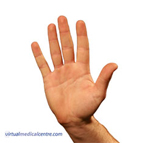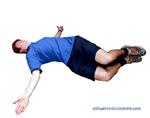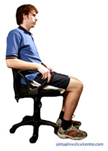- Introduction to Arthritis and Physical Activity
- How does physical activity help with arthritis?
- How often should I do physical activity?
- What activities can I do?
- Will I need to join a gym?
- Where else can I get help?
- Examples of basic exercises
- In Summary
|
Click here to watch a video on exercises for arthritic pain. |
Introduction to Arthritis and Physical Activity
Exercise therapy has been largely under-prescribed by GPs up until recently. For many years, it was suggested that patients with arthritis should avoid exercise, as it was thought to further inflame joints. But recently there has been a change in opinion, with many scientific studies suggesting that regular physical activity can reduce joint pain and possibly increase mobility, making it easier to perform everyday tasks.
How does physical activity help with arthritis?
Regular movement of the joints keeps them flexible and stops them from becoming stiff. This in turn leads a large reduction in the amount of pain felt in the joints. Exercise programs have been regularly proven to reduce joint pain in arthritis studies. If arthritis patients reduce the amount of exercise they do, then their muscles become weaker and their bones become more prone to fracture. Regular exercise maintains strength in the muscles and bones, decreasing the likelihood of falls and fractures. This leads to a greater quality of life and functional ability (ability to perform everyday tasks), while decreasing medical expenses. A long term exercise program can also be designed to help lose or maintain weight. Overweight is a large contributor to arthritis development, as it places extra strain on the joints. Physical activity can also benefit or reduce the likelihood of developing many other health conditions. Cardiovascular diseases, diabetes, high cholesterol levels, some cancers, osteoporosis and depression are just some of the conditions that exercise affects in a positive way. It is also a great way of getting out into the community and meeting new people!
How often should I do physical activity?
Ideally you should perform stretching exercises every day for at least 5-10 minutes. Early in the morning, after waking, is an ideal time to perform exercises, as it helps with early morning stiffness, preparing the body for daily activities. Very basic exercises, like those explained below, can be done everyday, even by those with very painful arthritis. If your symptoms permit, try to follow the guidelines for all healthy adults, and do at least 30 minutes of moderate activity on most, if not all, days of the week. However, you should listen to your own body to determine if you need to slow down a bit.
What activities can I do?
Simple chair or floor based exercises like those below are good for people who are just starting an exercise program, especially if you’re over 65 years of age or have been inactive for a period of time. These aim to increase flexibility as well as providing some gains in strength and balance. Yoga and tai chi can also provide benefits in these areas. They also have the benefit of being able to be done at home. If your symptoms are relatively mild, you might like to include aerobic activities like walking, swimming or dancing. You can even include resistance training to strengthen muscles. The effects of strength training on pain reduction can be seen earlier in the short term, but aerobic exercise has more long term effects. Any exercise program for arthritis should include a combination of stretching, strengthening and aerobic fitness work. Some of these activities should be joint specific exercises, based on the needs of the individual. Most importantly, they should be activities that you enjoy doing, so that you want to keep going back and doing more!
Will I need to join a gym?
There is no need to pay for a gym membership or hire a personal trainer. Many activities can be done at home or in a social group with very little instruction. If you perform the exercises correctly and safely, then you can achieve the same benefits, but without the great costs. However, to get the most from your program it may be a good idea to occasionally consult a trained professional or attend a ‘refresher’ course to make sure you are performing exercises correctly. This regular contact will help to provide you with more motivation to continue to exercise regularly.
Where else can I get help?
Your first stop before starting any program should be your GP or any other health professionals you consult about your arthritis. They will be able to tell what activities are appropriate for you and, if necessary, refer you to trained fitness professionals who can help to design your program. They can also direct you towards the various community groups that help arthritis patients. There are many affordable group classes for teaching exercise for arthritis, mostly run through the state based arthritis foundations. These include self management courses, yoga, tai chi and hydrotherapy, as well as a range of support groups. For more information on specialist group classes see the arthritis foundation from your state or territory.
Examples of basic exercises
Demonstrations and further explanation of these and other activities can be seen in the video at the top of the page.
Neck turns
While seated upright with the back straight, slowly turn the head to face the left and hold for 2 seconds before slowly returning and stopping facing forwards. Repeat to the right.
Fingertip stretches
Hold the hand in front, with the palm facing you. Slowly bend the finger joints so that the fingernails are facing you. Bend the knuckles, as if you’re making a fist, so that the fingertips contact the palm of the hand and squeeze lightly. Straighten and stretch apart the fingers. Do each hand separately as stiffness can vary between hands.
 |
 |
 |
Hip mobility
Lie on your back on your bed or the floor, with the hips and knees bent so that the feet are flat on the floor/bed. Slowly raise one leg towards your head, keeping the knee bent. Use the hands to apply gentle pressure to bring the leg closer and hold for two seconds before slowly lowering. Repeat with other leg.
 |
 |
Lower back mobility
From the same starting position as above, but with the arms out to the side, slowly roll the legs across to the right hand side, keeping the shoulders and chest flat on the floor/bed. Return to starting position and repeat to other side.
 |
 |
Quadriceps (upper leg) strengthening
Sit upright in a back supported chair, with feet on the floor. Slowly raise and straighten the right leg, with the toes pointing upwards and hold for 2-3 seconds before lowering gently. Repeat on each leg alternately, building up to 30 repeats.
 |
 |
Core stability strengthening
This refers to the tummy muscles, or abdominals, which are important in maintaining balance and preventing falls. On a solid surface (the floor is best), get down on hands and knees. Squeeze the tummy muscles and buttocks then slowly lift one arm to the side and hold for two seconds, then return and relax. If you’re unable to keep the arm straight as you lift, as shown below, try doing it with the elbow bent. Repeat with the other arm. Squeeze the tummy muscles and buttocks again, but this time, raise one leg and straighten it out behind you as far as comforable and hold for two seconds. Return, relax and the repeat with the other leg.
 |
 |
 |
In Summary
Arthritis can be a debilitating condition if left unmanaged. But the effects of this can be limited through the use of exercise therapy to reduce pain and improve your lifestyle. Through consultation with your health professionals you can design an exercise program to help you get the benefits of physical activity and manage your arthritis, so that you can continue to live your life in greater comfort!
References
- Arthritis Foundation of NSW. (2007, August). Arthritis New South Wales. Retrieved August 14, 2007. Available from: [URL Link]
- Bennell, K. & Hinman, R. (2005). Exercise as a treatment for osteoarthritis. Current Opinion in Rheumatology, 17, 634-640.
- Brady, T., Kruger, J., Helmick, C., Callahan, L. & Boutaugh, M. (2003). Intervention programs for arthritis and other rheumatic diseases. Health Education & Behaviour, 30(1), 44-63.
- Ytterberg, S., Mahowald, M. & Krug, H (1994). Exercise for arthritis. Bailliere’s Clinical Rheumatology, 8(1), 161-189
- Bennell, K., Hinman, R., Metcalf, B., Buchbinder, R., McConnell, J., McColl, G., Green, S. & Crossley, K. (2005). Efficacy of physiotherapy management of knee joint osteoarthritis: a randomized, double blind, placebo controlled trial. Annals of the Rheumatic Diseases, 64, 906-912.
All content and media on the HealthEngine Blog is created and published online for informational purposes only. It is not intended to be a substitute for professional medical advice and should not be relied on as health or personal advice. Always seek the guidance of your doctor or other qualified health professional with any questions you may have regarding your health or a medical condition. Never disregard the advice of a medical professional, or delay in seeking it because of something you have read on this Website. If you think you may have a medical emergency, call your doctor, go to the nearest hospital emergency department, or call the emergency services immediately.








